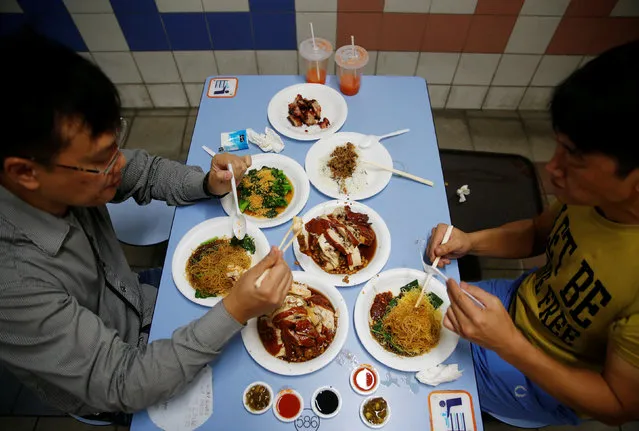
Patrons eat Michelin-starred soya sauce chicken noodles at Chinatown food centre in Singapore July 22, 2016. Singapore's beloved hawker industry faces an uncertain future with a wave of chef retirements imminent, raising questions about who will cook the city state's signature street-food delights. There are over 100 hawker centres and 6,000 stalls in Singapore, run mainly by ageing chefs, with people from all sections of society attracted to the tasty multi-ethnic meals that cost as little as S$2.80 ($2). But the tough working conditions in the small, basic kitchens and low profits have led many new chefs to look to larger, modern restaurants for bigger revenues. Some experienced hawker sellers in Singapore believe the younger generation don't have what it takes to succeed in the trade. (Photo by Edgar Su/Reuters)
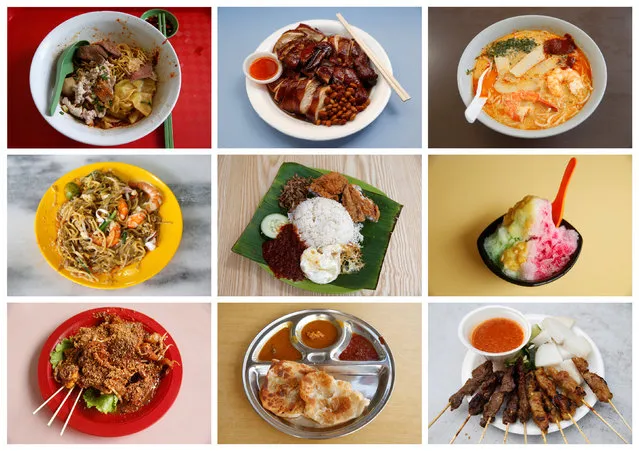
A combination photo shows various popular street foods under $6 from various hawker food stalls and eateries in Singapore, taken between July 28 to 31, 2016. Top row (L to R) bak chor mee, soya sauce chicken; Middle row (L to R) laksa, hokkien mee, nasi lemak, ice kachang; Bottom row (L to R) rojak, roti prata and satay. (Photo by Edgar Su/Reuters)
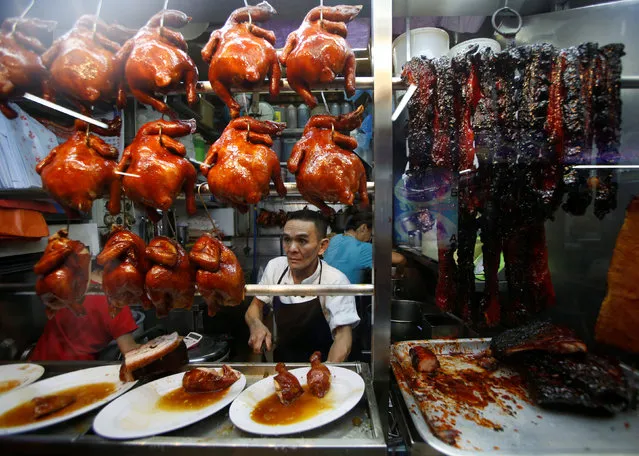
Hawker Chan Hong Meng, who won a Michelin star, sells soya sauce chicken at his Hong Kong Soya Sauce Chicken Rice and Noodle stall at Chinatown food centre in Singapore July 22, 2016. “The Michelin star came to me as a surprise, I never expected that hawker food will win such an award”, he said. “But with the Michelin star comes added responsibility, to maintain the standard of the dish and to keep the star... but I will not raise prices, at the end, its the customer that matters”. (Photo by Edgar Su/Reuters)
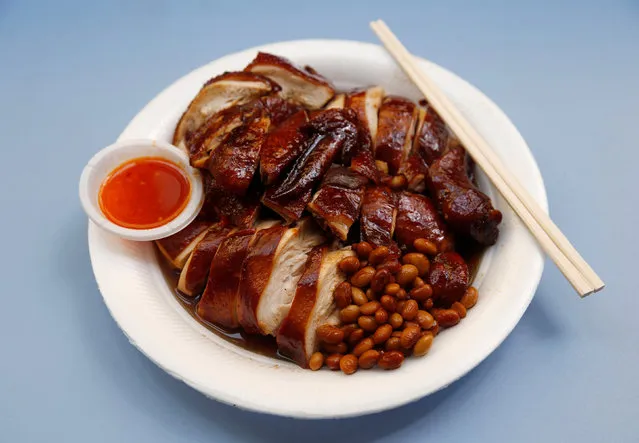
A plate of $5.20 soya sauce chicken is seen at Hong Kong Soya Sauce Chicken Rice & Noodle stall, which recently won a Michelin star, in Chinatown, in Singapore July 29, 2016. (Photo by Edgar Su/Reuters)
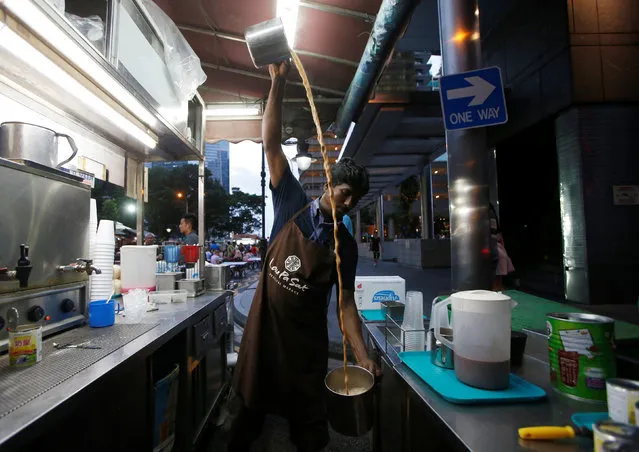
A hawker “pulls” tea at his Teh Tarik stall at Lau Pa Sat food centre in Singapore July 29, 2016. (Photo by Edgar Su/Reuters)
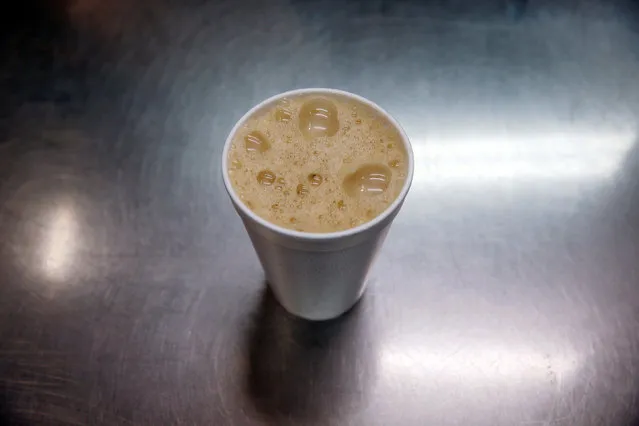
A cup of $1.10 teh tarik (pulled tea) is seen at Lau Pa Sat food centre in Singapore August 10, 2016. Teh tarik is made from black tea, condensed milk or evaporated milk. It is considered the national drink of Hong Kong. (Photo by Edgar Su/Reuters)
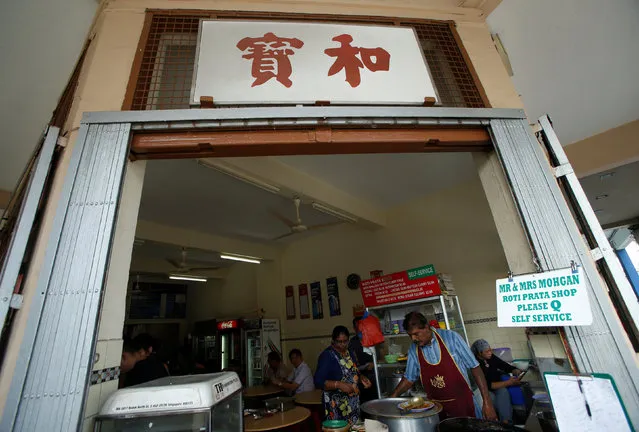
Sumosundram Moghan, 50, makes Roti Prata at his stall in Singapore on August 9, 2016. “The boss must do it – everyone can make the same dough but the way I flip my prata gives it the crispy standard”, he said. “My assistant has been learning for eight years, but still not doing the way I want it”. (Photo by Edgar Su/Reuters)
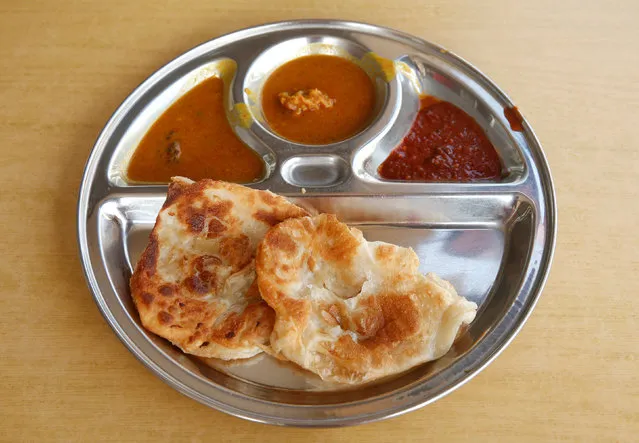
A plate of roti prata, costing $1,50, is seen at a stall in eastern Singapore August 9, 2016. Roti prata is a fried flour-based pancake that is cooked over a flat grill. It is usually served with a vegetable- or meat-based curry and is from Malaysia and Singapore. Prata is also commonly cooked upon request with cheese, onion, banana, red bean, chocolate, mushroom or egg. It is listed at number 45 in the World's 50 most delicious foods readers' poll compiled by CNN Go in 2011. (Photo by Edgar Su/Reuters)
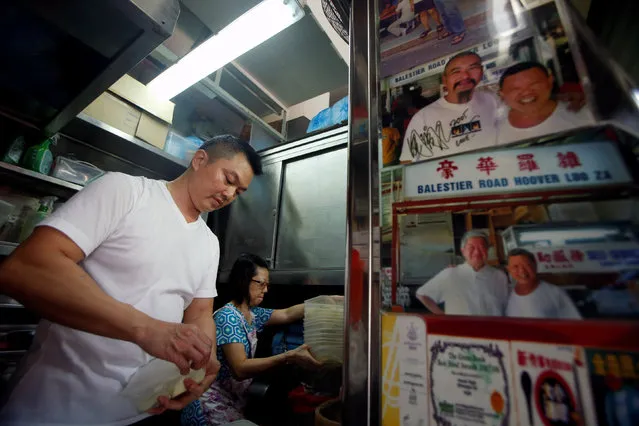
Hawker Stan Lim, 43, prepares his ingredients at Michelin Bib-Gourmand-awarded Balestier Road Hoover Rojak, at Whampoa Food Centre in Singapore August 12, 2016. The photograph (R) shows Hong Kong celebrity Chow Yun-Fat (top left) posing with Stan's father, Lim Ngah Chew, as Stan opened his doors for business. “Many of hawkers here at this food centre... told me to find something better outside and not be a hawker because its very hard work, long hours and very little rest”, he said. “But I took over my father three years ago because he was getting old. I do everything exactly he does, including how I arrange my utensils”. (Photo by Edgar Su/Reuters)

A plate of $3.70 rojak (fruit and vegetable salad) is seen at Balestier Road Hoover Rojak at Whampoa Food Centre in Singapore July 30, 2016. (Photo by Edgar Su/Reuters)
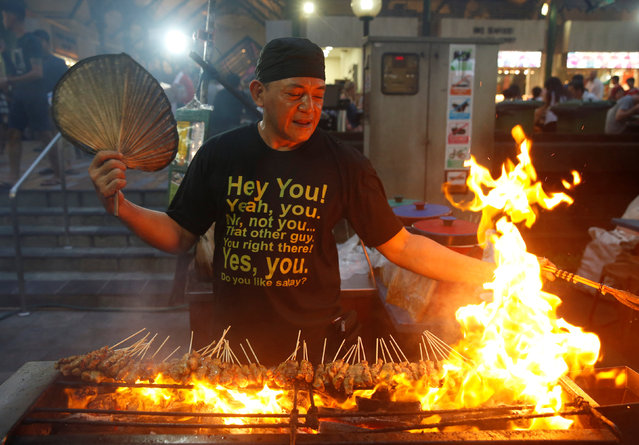
A stall helper mans a satay stand at Lau Pa Sat food centre in Singapore July 29, 2016. (Photo by Edgar Su/Reuters)
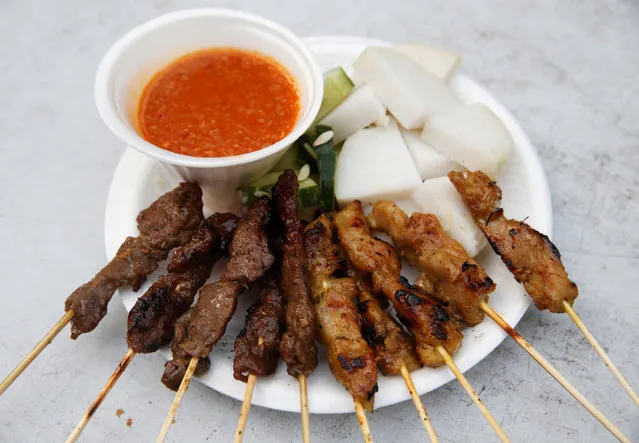
A plate of $5 satay (skewered meat) is seen at Asli Satay Club at Lau Pa Sat food centre in Singapore July 29, 2016. Satay is a dish of seasoned, skewered and grilled meat, served with a sauce. Satay may consist of diced or sliced chicken, goat, mutton, beef, pork, fish, other meats, or tofu; the more authentic version uses skewers from the midrib of the coconut palm frond, although bamboo skewers are often used. These are grilled or barbecued over a wood or charcoal fire, then served with various spicy seasonings. Close analogues are yakitori from Japan, shish kebab from Turkey and the Middle East, shashlik from the Caucasus, chuanr from China, and sosatie from South Africa. It is listed at number 14 on World's 50 most delicious foods readers' poll complied by CNN Go in 2011. (Photo by Edgar Su/Reuters)
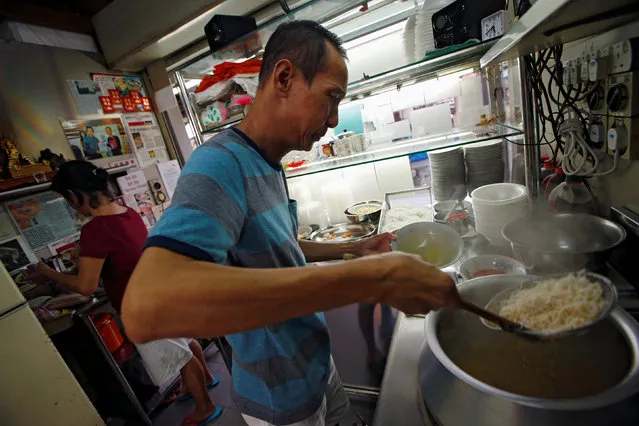
Hawker Lim Swee Heng prepares a bowl of laksa noodles, at Roxy Laksa stall, at the East Coast Lagoon Food Village in Singapore August 8, 2016. “It takes years to get the right balance to the broth, to make it thick just add coconut, to make it watery just add water, but to go in-between, to get that right balance – that's the hard work of my dish”. (Photo by Edgar Su/Reuters)
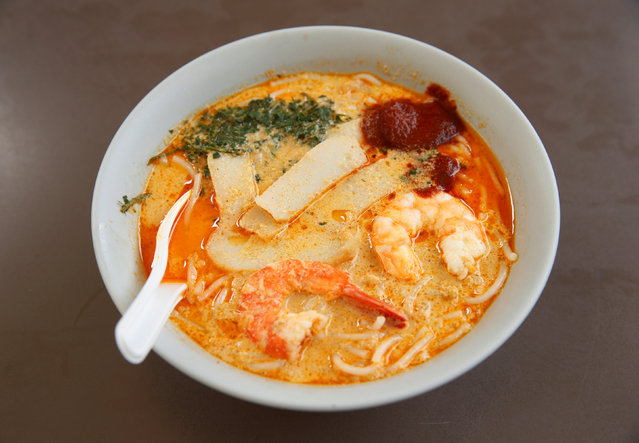
A bowl of $3.40 laksa is seen at Roxy Laksa stall at East Coast Lagoon Food Village in Singapore July 30, 2016. Laksa consists of rice noodles or rice vermicelli with chicken, prawn or fish, served in spicy soup; either based on rich and spicy curry coconut milk, or based on sour asam (tamarind or gelugur). (Photo by Edgar Su/Reuters)
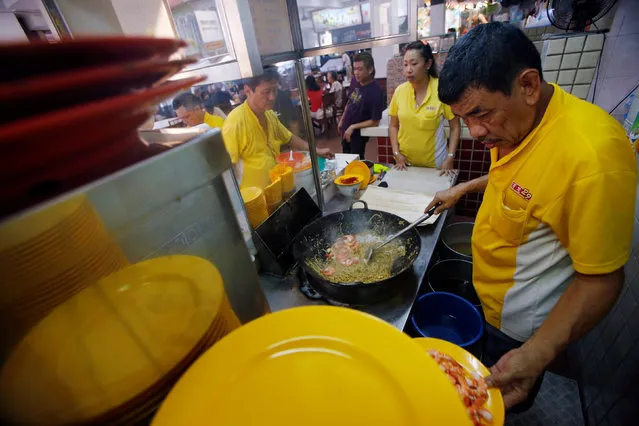
Hawker Alex See, 66, and his daughter Penny See, 33, cooking at their Geylang Lorong 29 Fried Hokkien Mee stall at East Coast Road in Singapore August 10, 2016. “Young people come and go, they are not serious about learning. When I was helping my father at the age of 16, I asked him so many questions everyday to learn so that I can one day beat him at it. I do not think I have beaten my old man yet, it's a tie”, See said. (Photo by Edgar Su/Reuters)

A plate of $3.70 hokkien mee (prawn noodles) is seen at Geylang Lorong 29 Fried Hokkien Mee at East Coast Road in Singapore July 30, 2016. Hokkien mee is a dish in Malaysian and Singaporean cuisine that has its origins in the cuisine of China's Fujian (Hokkien) province. In its most common form, the dish consists of egg noodles and rice noodles stir-fried with egg, slices of pork, prawns and squid, and served and garnished with vegetables, small pieces of lard, sambal sauce and lime (for adding the lime juice to the dish). (Photo by Edgar Su/Reuters)
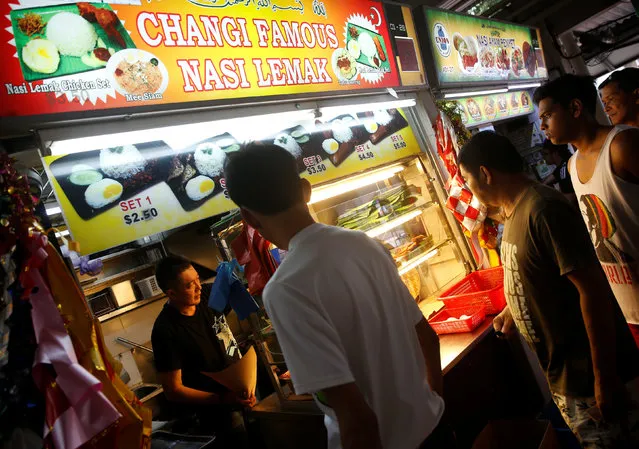
Stall helper Din Mohammad Rasheed, 50, attends to customers at Changi Famous Nasi Lemak stall at Changi Village Food Center in Singapore August 8, 2016. “Although nasi lemak is not an expensive food, the quality of the ingredients must be good, so customers come back”, Din said. (Photo by Edgar Su/Reuters)
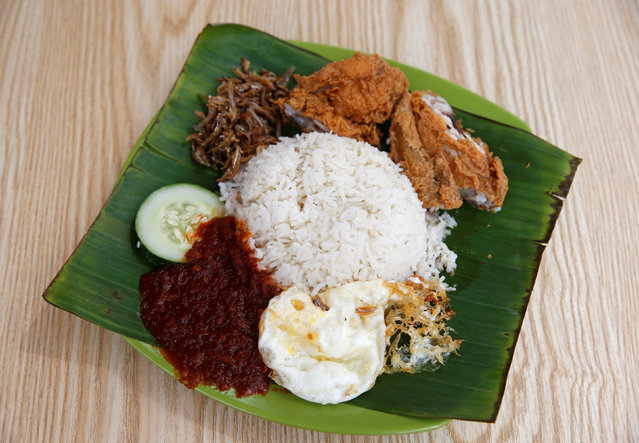
A plate of $2.60 nasi lemak is seen at Changi Famous Nasi Lemak at Changi Village Food Center in Singapore July 30, 2016. Nasi lemak is a Malay fragrant rice dish cooked in coconut milk and pandan leaf. It is considered one of the most famous dishes for a Malay-style breakfast. It is not to be confused with nasi dagang, sold in the Malaysian east coast states of Terengganu and Kelantan, although both dishes are often served for breakfast. However, because nasi lemak can be served in a variety of manners, it is often eaten throughout the day. Nasi lemak was also recently voted one of the top 10 healthy breakfast foods by TIME magazine. (Photo by Edgar Su/Reuters)
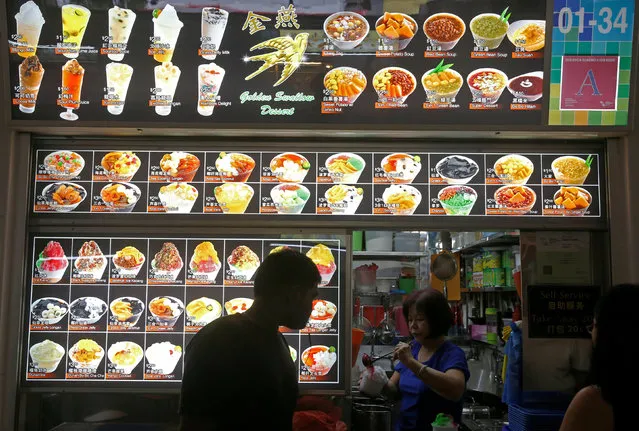
Hawker Chan Lay Choo, 62, attends to customers at Golden Swallow Dessert stall at Ghim Moh Food Centre in Singapore August 2, 2016. “Me and my husband have been here at the same stall for 39 years, and Ice Kachang has changed so much over the years – We used to just have shaved ice and syrup, but these days we keep up the trend by adding toppings like mango, peanuts and durian. The old will like the original but young people will like to try new flavours”, Chan said. (Photo by Edgar Su/Reuters)
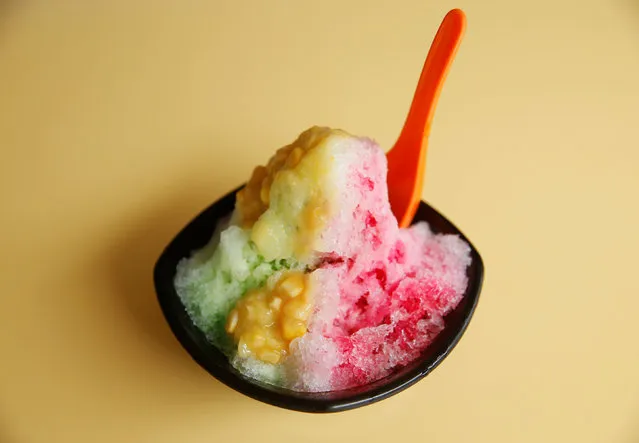
A bowl of $1.50 ice kachang (shaved ice dessert) is seen at Golden Swallow Dessert stall at Ghim Moh Food Centre in Singapore July 31, 2016. Ais kacang, literally meaning “ice beans”, also commonly known as ABC (acronym for Air Batu Campur, meaning “mixed ice”), is a Malaysian dessert which is also common in Singapore (where it is called ice kacang) and Brunei. Ais kacang was originally made of only shaved ice and red beans, though the number and diversity of ingredients has since expanded. Today, ais kacang generally comes in bright colours, and with different fruit cocktails and dressings. In Malaysia, almost all variants now contain a large serving of attap chee (palm seed), red beans, sweet corn, grass jelly and cubes of agar agar as common ingredients. Other less-common ingredients include aloe vera, cendol, nata de coco, or ice cream. A final topping of evaporated milk, condensed milk, or coconut milk is drizzled over the mountain of ice along with red rose syrup and sarsi syrup. Some stalls have even introduced novelty toppings such as durian, chocolate syrup and ice cream. There are also versions that shun the multi-coloured syrup and are served with just a drizzling of gula melaka syrup instead. (Photo by Edgar Su/Reuters)
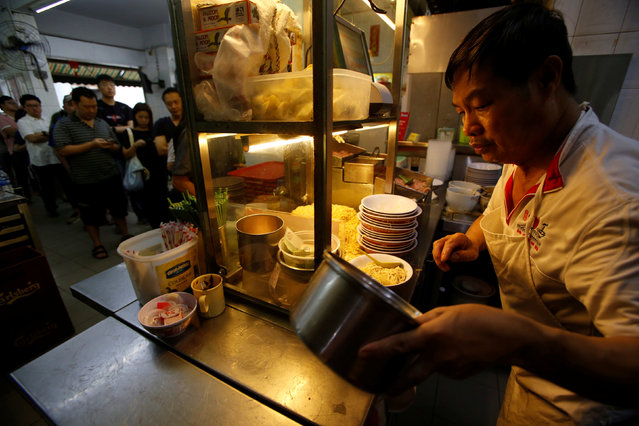
A stall helper cooks as people queue for Michelin-starred bak chor mee (mince pork noodles) at Hill Street Tai Hwa Pork Noodles stall in Singapore July 22, 2016. (Photo by Edgar Su/Reuters)
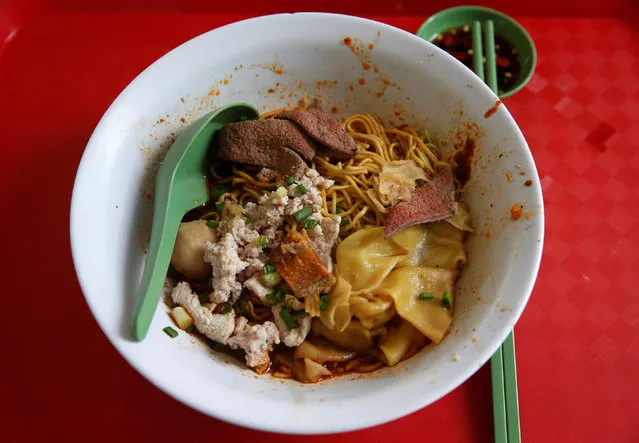
A bowl of $3.70 bak chor mee (mince pork noodles) is seen at Hill Street Tai Hwa Pork Noodles, which recently won a Michelin star, in Singapore July 28, 2016. Mee pok is a noodle dish with Chinese noodle characterized by its flat and yellow appearance, varying in thickness and width. Mee Pok is commonly served tossed in a sauce (often referred to as “dry”, or tah), though sometimes served in a soup (where it is referred to as “soup”, or terng). Meat and vegetables are added on top. Mee pok can be categorised into two variants, fish ball mee pok (yu wan mee pok), and mushroom minced meat mee pok (bak chor mee). Bak chor mee is usually exclusively prepared using thin noodles (“mee kia”), while yu wan mee can be cooked with other noodle varieties. (Photo by Edgar Su/Reuters)
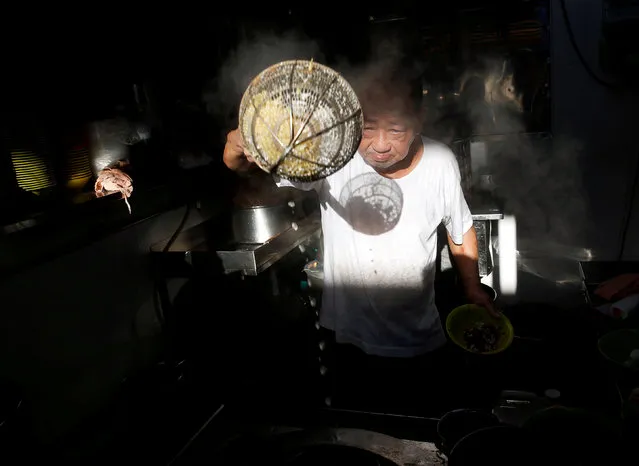
Hawker Wee Phong Sai, 66, cooks fishball noodles at his Thye Hong Handmade Fishball Noodle stall at Ghim Moh food center in Singapore May 21, 2016. “I have been here, at this stall, since 1977; all of my five brothers sell fishball noodles, although two of them have retired. I continue to make fishballs by hand because it gives them a softer texture”, he said. “To retire? These are two words that I will not utter”. (Photo by Edgar Su/Reuters)
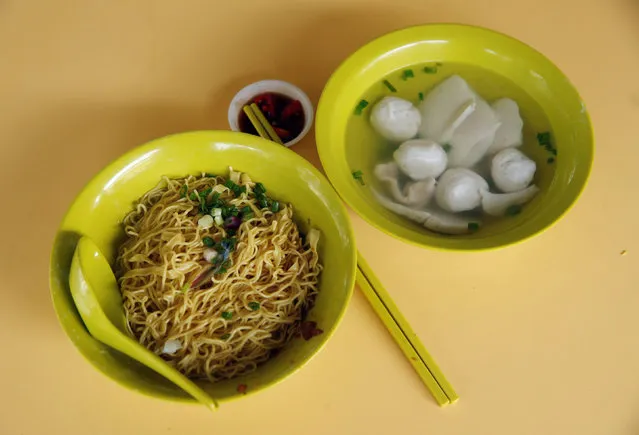
A $2.20 bowl of fishball noodles is seen at Thye Hong Handmade Fishball Noodle stall at Ghim Moh food center in Singapore August 12, 2016. (Photo by Edgar Su/Reuters)
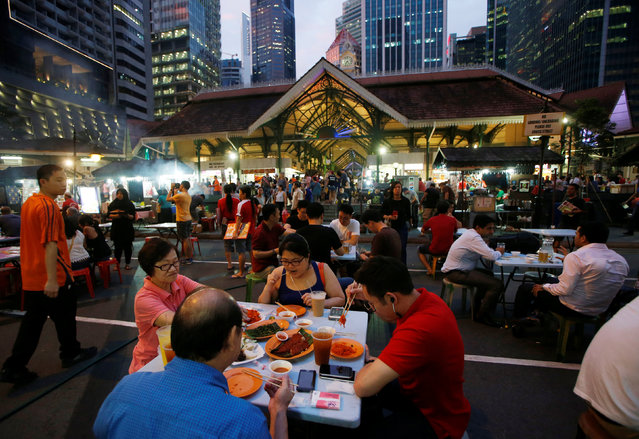
People eat at Lau Pa Sat food centre in Singapore July 29, 2016. (Photo by Edgar Su/Reuters)
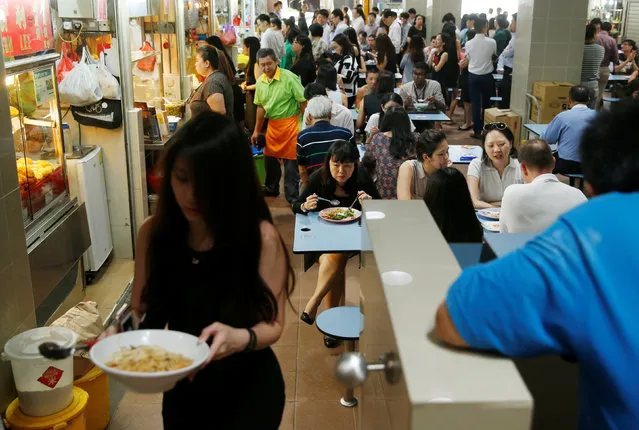
People queue for food at Amoy food centre in Singapore August 1, 2016. (Photo by Edgar Su/Reuters)
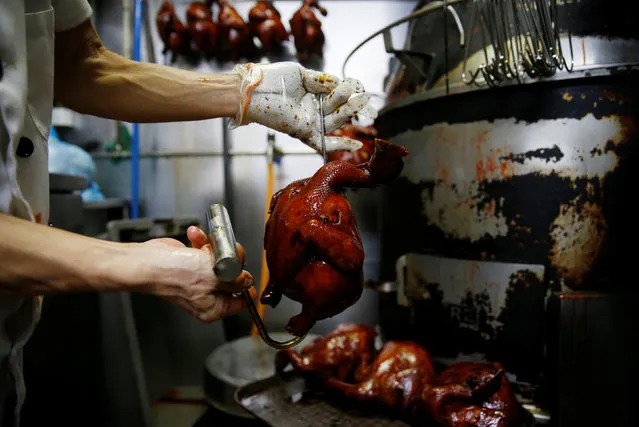
Michelin-starred hawker Chan Hong Meng prepares his soya sauce chickens at his Hong Kong Soya Sauce Chicken Rice and Noodle stall at Chinatown food centre in Singapore July 29, 2016. (Photo by Edgar Su/Reuters)
27 Aug 2016 10:55:00,
post received
0 comments
